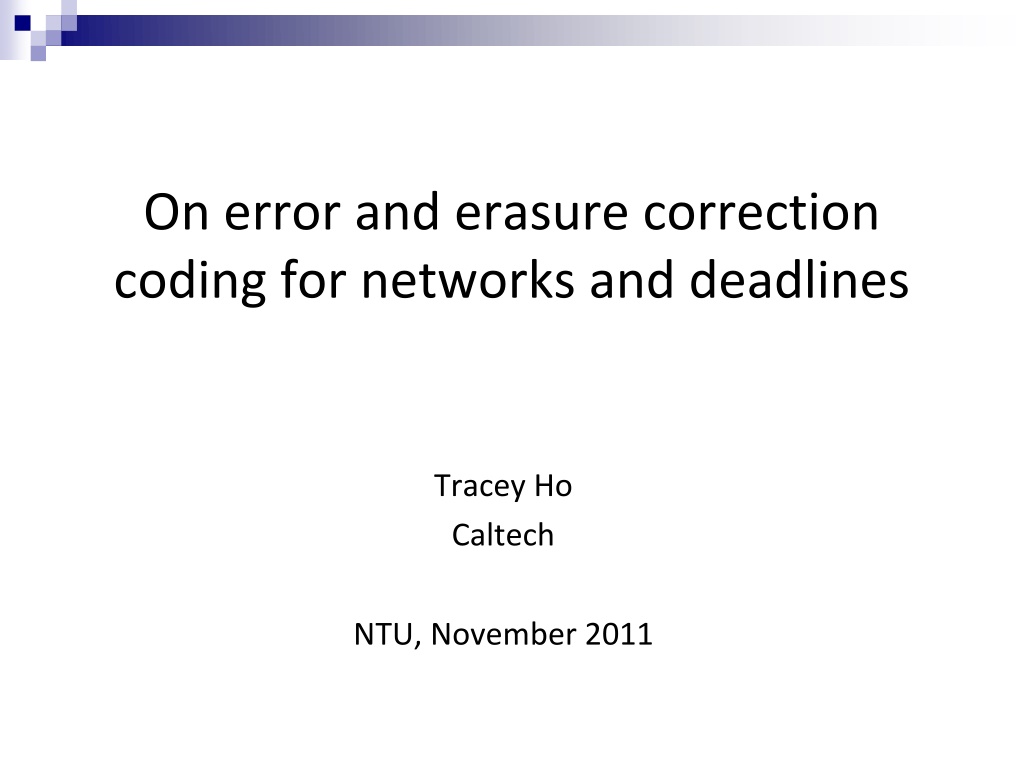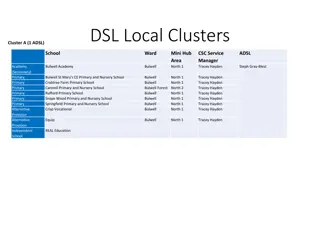
Theory and Applications of Network Error Correction
Explore the theory and applications of network error correction, covering topics such as multi-source multicast, coding for deadlines, combining information theory and cryptographic security, and handling non-uniform errors in network communications. Learn about reliable communication under errors and erasures, with a focus on achieving reliable communication with arbitrary errors on network links. Discover the background and solutions for network error correction problems introduced by Cai & Yeung and other experts in the field.
Download Presentation

Please find below an Image/Link to download the presentation.
The content on the website is provided AS IS for your information and personal use only. It may not be sold, licensed, or shared on other websites without obtaining consent from the author. Download presentation by click this link. If you encounter any issues during the download, it is possible that the publisher has removed the file from their server.
E N D
Presentation Transcript
On error and erasure correction coding for networks and deadlines Tracey Ho Caltech NTU, November 2011
Network error correction problem s2 t1 s1 t2 z unknown erroneous links network Problem of reliable communication under arbitrary errors on z links (or packets) The set of erroneous links is fixed but unknown to the network user cannot do error correction on individual links separately Erasure correction is a related problem 2
Background network error correction The network error correction problem was introduced by [Cai & Yeung 03] Extensively studied in the single-source multicast case with uniform errors Equal capacity network links (or packets), any zof which may be erroneous Various capacity-achieving code constructions, e.g. [Cai & Yeung 03, Jaggi et al. 07, Zhang 08, Koetter & Kschischang 08]
This talk : theory and applications of network error correction 1. Multi-source multicast network error correction Application to key pool bootstrapping 2. Network error/erasure correction as a model for analyzing reliable communication with deadlines 3. Combining information theoretic and cryptographic security against adversarial errors for computationally limited nodes x x t1 t2 t3 I1 I1, I2 I1, I2, I3 m1 I1 m3 I3 m2 I2
This talk : theory and applications of network error correction 1. Multi-source multicast network error correction Application to key pool bootstrapping 2. Network error/erasure correction as a model for analyzing reliable communication with deadlines 3. Combining information theoretic and cryptographic security against adversarial errors for computationally limited nodes 4. Non-uniform network error correction
Outline Multiple-source multicast, uniform errors Coding for deadlines: non-multicast nested networks Combining information theoretic and cryptographic security: single-source multicast Non-uniform errors: unequal link capacities
Outline Multiple-source multicast, uniform errors T. Dikaliotis, T. Ho, S. Jaggi, S. Vyetrenko, H. Yao, M. Effros, J. Kliewer and E. Erez, IT Transactions 2011. Coding for deadlines: non-multicast nested networks Combining information theoretic and cryptographic security: single-source multicast Non-uniform errors: unequal link capacities
Background single-source multicast, uniform zerrors Capacity = min cut 2z, achievable with linear network codes (Cai & Yeung 03) Capacity-achieving codes with polynomial-time decoding: Probabilistic construction (Jaggi, Langberg, Katti, Ho, Katabi & Medard 07) Lifted Gabidulin codes (Koetter & Kschischang 08, Silva, Kschischang & Koetter 08) 8
Multiple-source multicast, uniform z errors Source 1 Source 2 Sources with independent information We could partition network capacity among different sources But could rate be improved by coding across different sources in the network? To what extent can different sources share network capacity? Challenge: owing to the need for coding across sources in the network and independent encoding at sources, straightforward extensions of single-source codes are suboptimal Related work: code construction in (Siavoshani, Fragouli & Diggavi 08) achieves capacity for C1+C2=C Sink
Multiple-source multicast, uniform z errors Source 1 Source 2 Sources with independent information We could partition network capacity among different sources But could rate be improved by coding across different sources in the network? To what extent can different sources share network capacity? Challenge: owing to the need for coding across sources in the network and independent encoding at sources, straightforward extensions of single-source codes are suboptimal Related work: code construction in (Siavoshani, Fragouli & Diggavi 08) achieves capacity for C1+C2=C Sink
Multiple-source multicast, uniform z errors Source 1 Source 2 Sources with independent information We could partition network capacity among different sources But could rate be improved by coding across different sources in the network? To what extent can different sources share network capacity? Challenge: owing to the need for coding across sources in the network and independent encoding at sources, straightforward extensions of single-source codes are suboptimal Related work: code construction in (Siavoshani, Fragouli & Diggavi 08) achieves capacity for C1+C2=C Sink
Multiple-source multicast, uniform z errors Source 1 Source 2 Sources with independent information We could partition network capacity among different sources But could rate be improved by coding across different sources in the network? To what extent can different sources share network capacity? Challenge: owing to the need for coding across sources in the network and independent encoding at sources, straightforward extensions of single-source codes are suboptimal Related work: code construction in (Siavoshani, Fragouli & Diggavi 08) achieves capacity for C1+C2=C Sink
Multiple-source multicast, uniform z errors Source 1 Source 2 Sources with independent information We could partition network capacity among different sources But could rate be improved by coding across different sources in the network? To what extent can different sources share network capacity? Challenge: owing to the need for coding across sources in the network and independent encoding at sources, straightforward extensions of single-source codes are suboptimal Related work: code construction in (Siavoshani, Fragouli & Diggavi 08) achieves capacity for C1+C2=C Sink
Capacity region U= set of source nodes mS= min cut capacity between sources in subset S of U and each sink ri= rate from the ithsource Theorem: The capacity region (coherent & non-coherent) under any z link errors is given by the cut set bounds U S z m r S i Source 1 2 , i S Source 2 Example: z = 1 r1 m1 -2z =1 r2 m2 -2z = 1 (r1 + r2 m -2z = 2) Sink
Capacity region U= set of source nodes mS= min cut capacity between sources in subset S of U and each sink ri= rate from the ithsource Theorem: The capacity region (coherent & non-coherent) under any z link errors is given by the cut set bounds U S z m r S i Source 1 2 , i S Source 2 Example: z = 1 r1 m1 -2z =1 r2 m2 -2z = 1 (r1 + r2 m -2z = 2) Redundant capacity is completely shared! Sink
Achievable constructions 1. Probabilistic construction, joint decoding of multiple sources Requires a different distance metric for decoding than single source multicast decoding metric from Koetter & Kschischang 08 2. Gabidulin codes in nested finite fields, successive decoding
Background - Gabidulin codes n 1 F F M = M = r r q q n
Background - Gabidulin codes n 1 1 F F q M = = * F GM = r n n q r+t q ChannelGM+E GM Transmit [I x], where x is a codeword of a Gabidulin code Achieves capacity C 2z for single-source multicast with efficient decoding algorithms (Koetter & Kschischang 08, Silva, Kschischang & Koetter 08)
Nested Gabidulin codes for multiple source multicast Interior nodes do random linear network coding in GF(q) Sources encode with Gabidulin codes over nested extension fields GF(q ), GF(q ), , GF(q ) whereni ri +2z Enables successive decoding at the sinks, starting from outermost source k n1 n1n2 n1n2 nk.
Nested Gabidulin codes - 2 sources Y=T1G1M1+T2G2M2+E (1) M 1 = + G 1 G Y T T E (2) 1 1 2 G G M 2 2 2 = G m m D D T G 1 T F invertible whp for RLNC 1 2 1 n 1 q M 1 (D-1Y) = + D D-1E 1 E lowest r2+2z rows G G M 2 2 2 (D-1Y) = + G G ( (D-1E) 1 ) M D E (3) 2 2 2 Matrix of rank z over Fq n1 Matrix of rank z over Fq
An application: key pool bootstrapping A key center generates a set of keys {K1, K2, }, a subset of which needs to be communicated to each network node Instead of every node communicating directly with the key center, nodes can obtain keys from neighbors who have the appropriate keys Use coding to correct errors from corrupted nodes
Key pool bootstrapping Problem is equivalent to multi-source network error correction V1 V2 V3 V4 V5 V6 V7 V8 V9 k1, k2 k1, k2 k1, k2 k1, k3 k1, k3 k1, k3 k2, k3 k2, k3 k2, k3 R S1 S2 S3 V1 V2 V3 V4 V5 V6 V7 V8 V9 R Coding across keys is needed for optimal error resilience
Outline Multiple-source multicast, uniform errors Coding for deadlines: non-multicast nested networks O. Tekin, S. Vyetrenko, T. Ho and H. Yao, Allerton 2011. Combining information theoretic and cryptographic security: single-source multicast Non-uniform errors: unequal link capacities
Background - non-multicast Finding the capacity region of a general non-multicast network even in the erasure-free case is an open problem Coding across different sinks packets (inter-session coding) is sometimes required We don t know in general when intra-session coding is sufficient We can derive cut set bounds by analyzing three-layer networks (Vyetrenko, Ho & Dikaliotis 10)
Motivation x x Packet erasures/errors m1 I1 m3 I3 Demanded information m2 I2 Initial play-out delay Decoding deadlines
Three-layer nested networks A model for temporal demands Links Packets Sinks Deadlines by which certain information must be decoded Each sink receives a subset of the information received by the next (nested structure) Packet erasures can occur Non-multicast problem t1 t2 t3 I1 I1, I2 I1, I2, I3
Erasure models We consider two erasure models: z erasures (uniform model) At most z links can be erased, locations are unknown a priori. Sliding window erasure model
z erasures upper bounding capacity Want to find the capacity region of achievable rates u1,u2, ,un We can write a cut-set bound for each sink and erasure pattern (choice of z erased links) u1 m1 z u1+u2 m2 z u1+u2+ +un mn z Can we combine bounds for multiple erasure patterns and sinks to obtain tighter bounds? t1 t2 t3 I1 I1, I2 I1, I2, I3
Cut-set combining procedure Example: m1=3,m2=5, m3=7, m4=11, z=1 u1+H(X1X2|I1) 2 u1+H(X1X3|I1) 2 u1+H(X2X3|I1) 2 12 1245 124567 13 1345 134567 1234567 23 2345 234567 1234 1235 123467 123567 1234567 123456 123457 1234567 123456 123457 1234567 Iteratively apply steps: Extend: H(X |I1i-1)+ |Y| H(X,Y |I1i-1)= H(X,Y |I1i)+ ui 1234567 where X,Y is a decoding set for Ii = | | k 1 X i i Combine: ( , | ) ( , | ) H Z A I H Z X I 1 1 : | , | A A X A k
Upper bound derivation graph Example: m1=3,m2=5, m3=7, m4=11, z=1 Capacity region: 12 1245 124567 u1 2 3u1+2u2 8 3u1+2u2+u3 9 6u1+5u2+4u3 24 6u1+4u2+2u3+u4 20 9u1+6u2+4u3+3u4 36 6u1+5u2+4u3+2u4 28 6u1+4.5u2+4u3+3u4 30 9u1+7.5u2+7u3+6u4 54 13 1345 134567 1234567 23 2345 234567 1234 1235 123467 123567 1234567 123456 123457 1234567 123456 123457 1234567 1234567 Different choices of links at each step give different upper bounds Exponentially large number of bounds Only some are tight how to find them? We use an achievable scheme as a guide and show a matching upper bound
Intra-session Coding yj,k : capacity on kthlink allocated to jth message We may assume yj,k = 0 for k>mj P : set of unerased links with at most z erasures A rate vector (u1,u2, ,un) is achieved if and only if: 1 2 mn P u1 I1 y1,1 y1,2 y1,m_n I2 y2,1 y2,2 y2,m_n u2 In yn,1 1 yn,1 1 yn,m_n un 1
As uniform as possible intra-session coding scheme Fill up each row as uniformly as possible subject to constraints from previous rows Example: u u u u u 4 u 4 3 4 * . 0 25 6 18 3 3 4 4 3 u m1 = 10, m2 = 14, m3 = 18, m4 = 22, u1 = 6, u2 = 3, u3 = 3, u4 = 4, z=2 = 3 = = = z z = z = = = . 0 . 0 = = 10 2 10 = = = 5 . 0 4 . 0 5 . 0 = 75 25 1875 . 0 2 2 2 14 2 . 0 4 1 z z 3 z 1 z 1 2 3 4 1 2 m 4 m m 2 2 2 2 22 10 14 18 22 22 m m m m m 3 m 4 m 11,12,13,14 15,16,17,18 19,20,21,22 1,2, ,9,10 I1 0.75 I2 0.25 0.25 I3 0.1875 0 0.1875 0.5 0.1875 0.5 I4 0.2 0 0 0.4 0.2 0.25 0.4 0.2 0.5 0.4 0.2 0.5 Can we do better?
Capacity region Theorem: The z-erasure (or error) correction capacity region of a 3-layer nested network is achieved by the as uniform as possible coding scheme.
Proof Idea Consider any given rate vector (u1,u2, ,un) and its corresponding as uniform as possible allocation: m1+1, ,m2 m2+1, ,m3 mn-1+1, ,mn 1,2, ,m1 I1 I2 I3 T1,1 T2,1 T3,1 T2,2 T3,2 T3,3 In Tn,1 Tn,2 Tn,3 Tn,n Obtain matching information theoretic bounds, by using Ti,j values to choose path through upper bound derivation graph
Proof Idea mn mk m2 m1 W1 W2 Wk = with at most z k W Consider any unerased set erasures. Show by induction: The conditional entropy of Wgiven messages I1, , Ik matches the residual capacity in the table, i.e. = i 1 ... W W W 1 2 k k = j W ( | ,..., ) | 1 ( | ) H I I W T 1 , k i j i 1
Proof Idea V For any set H(V| I1k) can be derived as follows: let V be the subset of V consisting of links upstream of tk-1 obtain H(V | I1k-1) from the table (induction hypothesis) extend : H(V |I1k) H(V |I1k-1)+ |V \V | uk For each row k, there exists a column k* such that all Ti,jare all equal for j>k* Combine over all such having erasures on links mk*+1,mk*+2, , mkto obtain: = i 1 with |V|= mk-z, an upper bound for W V W k k = j W ( | ,..., ) | 1 ( | ) H I I W T 1 , k i i j 1
z-error capacity region A linear non-multicast code that can correct 2z erasures can correct z errors [Vyetrenko, Ho, Effros, Kliewer & Erez 09] An arbitrary code for a three-layer network that can correct z errors can correct 2z erasures (Singleton-type argument) Since our capacity-achieving code is linear, the z-error capacity region is the same as the 2z-erasure capacity region
Sliding window erasure model Parameterized by erasure rate p and burst parameter T. For y T, at most py out of y consecutive packets can be erased. Erasures occur with rate p in long term. Erasure bursts cannot be too long (controlled by T ).
Sliding window erasure achievable region u Theorem: Let the rate vector be achievable. Then the rate vector 1 1 p u 1 + m T + 1 p + 1 log 1 T m 1 is achieved by as uniform as possible coding. Note: asymptotically optimal for m1 >> T >>1
Outline Multiple-source multicast, uniform errors Coding for deadlines: non-multicast nested networks Combining information theoretic and cryptographic security: single-source multicast S. Vyetrenko, A. Khosla & T. Ho, Asilomar 2009. Non-uniform errors: unequal link capacities
Problem statement Single source, multicast network Packets may be corrupted by adversarial errors Computationally limited network nodes (e.g. low-power wireless/sensor networks)
Background: information-theoretic and cryptographic approaches Information theoretic network error correction Existing codes are designed for a given upper bound zU on the number of errors, achieve rate mincut -2zU, e.g. [Yeung and Cai 03] Cryptographic signatures with erasure correction Cryptographic signatures allow network coded packets to be validated, e.g. [Zhao et al. 07, Boneh et al. 09] If all packets are signed and each network node checks all packets, then rate mincut - z can be achieved, where zis the actual number of erroneous packets
Motivation for hybrid schemes Performing signature checks at network nodes requires significant computation Checking all packets at all nodes can limit throughput when network nodes are computationally weak Want to use both path diversity as well as cryptographic computation as resources, to achieve rates higher than with each separately
Approach Cannot afford to check all packets use probabilistic signature checking Deterministic bound on number of erroneous packets is needed in existing network error correction code constructions Rather than have to choose a conservative bound, we want a code construction that does not require an upper bound on the number of errors to be known in advance
Fountain-like network error correction code We propose a fountain-like error-correcting code which incrementally sends redundancy until decoding succeeds (verified by signature checks) Each adversarial error packet can correspond to an addition (of erroneous information) and/or an erasure (of good information) Construction: B I 0 Message B I Linearly independent redundancy Linearly dependent redundancy For additions 0 0 I Linearly independent redundancy For erasures Linearly dependent redundancy
Example: simple hybrid strategy on wireless butterfly network source Node D has limited computation and outgoing capacity Carries out probabilistic signature checking/coding Proportion of packets checked/coded chosen to maximize expected information rate subject to computational budget D sink sink 1 2
Example: simple hybrid strategy on wireless butterfly network cost of checking = = = 40 , mincut 200 , 20 z cost of coding
Outline Multiple-source multicast, uniform errors Coding for deadlines: non-multicast nested networks Combining information theoretic and cryptographic security: single-source multicast Non-uniform errors: unequal link capacities S. Kim, T. Ho, M. Effros and S. Avestimehr, IT Transactions 2011. T. Ho, S. Kim, Y. Yang, M. Effros and A. S. Avestimehr, ITA 2011.
Uniform and non-uniform errors Uniform errors: Multicast error correction capacity = min cut 2z Worst-caseerrors occur on the min cut Non-uniform errors: Model: network with unequal link capacities, adversarial errors on any z fixed but unknown links Not obvious what are worst-case errors Cut size versus link capacities Feedback across cuts matters Related work: Adversarial nodes (Kosut, Tong & Tse 09)
Network cuts Only forward link capacities matter in the equal link capacity case S Both forward and feedback links matter in the unequal link capacity case Feedback can provide information about errors on upstream links U 50
















